The Evidence Collection Tubes Market is estimated to be valued at USD 15.0 billion in 2025 and is projected to reach USD 66.4 billion by 2035, registering a compound annual growth rate (CAGR) of 16.0% over the forecast period.
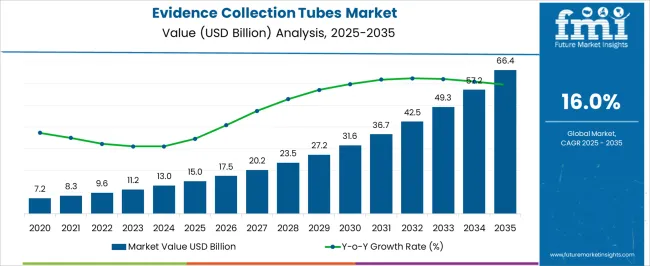
| Metric | Value |
|---|---|
| Evidence Collection Tubes Market Estimated Value in (2025 E) | USD 15.0 billion |
| Evidence Collection Tubes Market Forecast Value in (2035 F) | USD 66.4 billion |
| Forecast CAGR (2025 to 2035) | 16.0% |
The evidence collection tubes market is experiencing steady growth, driven by the increasing demand for reliable and efficient biological sample management in clinical, diagnostic, and research settings. The market is supported by rising healthcare infrastructure investments, particularly in hospitals and diagnostic laboratories, where precise sample collection and preservation are critical for accurate testing.
Technological advancements in tube materials, sealing mechanisms, and anticoagulant formulations are enhancing the stability and integrity of collected specimens, thereby improving test accuracy and reducing contamination risks. The adoption of automated handling and high-throughput processing systems is further encouraging the use of specialized collection tubes.
Additionally, increasing awareness of laboratory safety standards and compliance with regulatory guidelines are influencing procurement decisions, favoring high-quality evidence collection solutions As the global healthcare sector continues to expand and laboratory services grow, the market is positioned for sustained growth, with manufacturers focusing on innovation, product diversification, and distribution expansion to meet the evolving needs of hospitals, clinical laboratories, and research facilities worldwide.
The evidence collection tubes market is segmented by product, application, and geographic regions. By product, evidence collection tubes market is divided into Plasma Separation Tubes, Heparin Tubes, Serum Separating Tubes, EDTA Tubes, Rapid Serum Tubes, and Others. In terms of application, evidence collection tubes market is classified into Hospitals, Blood Testing Centers, and Others. Regionally, the evidence collection tubes industry is classified into North America, Latin America, Western Europe, Eastern Europe, Balkan & Baltic Countries, Russia & Belarus, Central Asia, East Asia, South Asia & Pacific, and the Middle East & Africa.
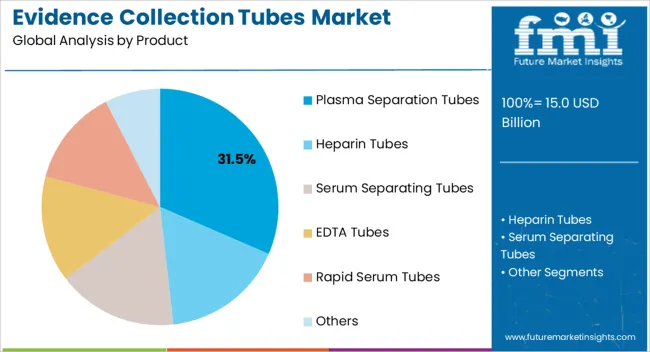
The plasma separation tubes segment is projected to hold 31.5% of the evidence collection tubes market revenue share in 2025, making it the leading product type. Its dominance is being supported by the ability to efficiently separate plasma from whole blood, ensuring sample integrity for a wide range of diagnostic tests, including biochemistry and immunology assays. The segment benefits from increased demand in hospitals and laboratories that require high-precision, contamination-free samples to improve test reliability.
Advanced tube designs with gel barriers or anticoagulant coatings are enhancing separation efficiency and sample stability, reducing pre-analytical errors and improving overall laboratory workflow. Growing adoption of automated blood collection and processing systems is further reinforcing the segment’s position by allowing seamless integration into high-throughput environments.
Manufacturers focusing on material innovation, such as low-hemolysis plastics and standardized volume formats, are ensuring consistent performance and reliability The combination of technological advancements, operational efficiency, and widespread applicability is sustaining the growth of plasma separation tubes as the preferred choice in clinical and research settings.
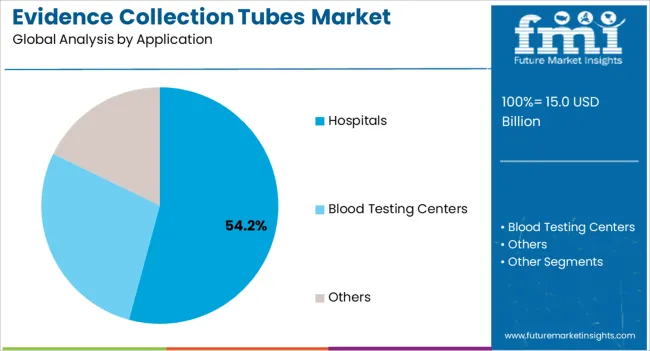
The hospitals application segment is expected to account for 54.2% of the evidence collection tubes market revenue share in 2025, establishing it as the leading end-use category. Hospitals are increasingly adopting specialized collection tubes due to the high volume of patient samples processed daily, which requires reliable and accurate sample management solutions. The segment’s growth is supported by expanding hospital infrastructure, rising patient admissions, and the growing complexity of diagnostic testing in modern healthcare settings.
Evidence collection tubes provide operational efficiency by ensuring sample integrity, reducing processing errors, and facilitating rapid testing turnaround times. Regulatory compliance and stringent laboratory standards in hospitals are further driving the preference for high-quality, pre-validated collection tubes.
The integration of automated sample handling and testing systems in hospital laboratories has also promoted the adoption of standardized tube formats that are compatible with automated analyzers As hospitals continue to expand services and prioritize laboratory efficiency, the demand for evidence collection tubes is expected to remain strong, reinforcing their market leadership in the healthcare sector.
In any kind of crime or untoward incident, evidence from the scene can go a long way in helping law enforcement agencies understand and frame a coherent picture of what transpired. This can include fingerprints, saliva, blood, semen samples, tissues under human fingernails, hair fibres etc. which is then scientifically examined in a forensic laboratory.
It can be critical in linking a suspect or perpetrator to a particular crime scene or victim. (In case of physical or sexual assault). This evidence must be handled with the utmost care as it can be easily contaminated with improper or direct handling. Ensuring that is the responsibility of the evidence collection tube market.
It is said by law enforcement agencies that “A zero crime rate is a hypothetical situation.” Hence, there would also be some form of crime in every country, a highly efficient police force and incorruptible government notwithstanding. That is why the future of the evidence collection tubes market looks very promising indeed.
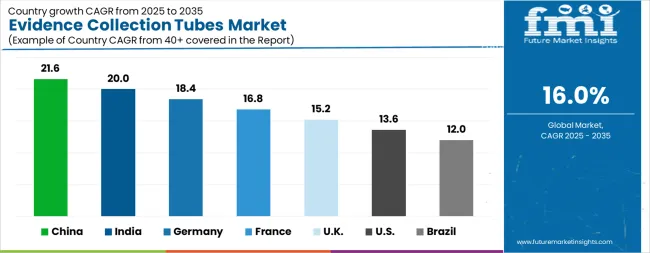
| Country | CAGR |
|---|---|
| China | 21.6% |
| India | 20.0% |
| Germany | 18.4% |
| France | 16.8% |
| UK | 15.2% |
| USA | 13.6% |
| Brazil | 12.0% |
The Evidence Collection Tubes Market is expected to register a CAGR of 16.0% during the forecast period, exhibiting varied country level momentum. China leads with the highest CAGR of 21.6%, followed by India at 20.0%. Developed markets such as Germany, France, and the UK continue to expand steadily, while the USA is likely to grow at consistent rates. Brazil posts the lowest CAGR at 12.0%, yet still underscores a broadly positive trajectory for the global Evidence Collection Tubes Market. In 2024, Germany held a dominant revenue in the Western Europe market and is expected to grow with a CAGR of 18.4%. The USA Evidence Collection Tubes Market is estimated to be valued at USD 5.2 billion in 2025 and is anticipated to reach a valuation of USD 18.5 billion by 2035. Sales are projected to rise at a CAGR of 13.6% over the forecast period between 2025 and 2035. While Japan and South Korea markets are estimated to be valued at USD 746.0 million and USD 443.8 million respectively in 2025.
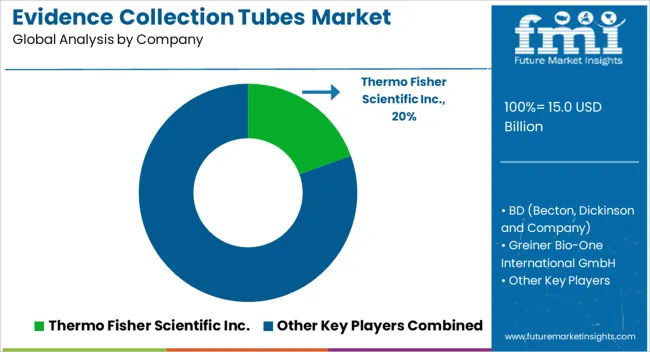
| Item | Value |
|---|---|
| Quantitative Units | USD 15.0 Billion |
| Product | Plasma Separation Tubes, Heparin Tubes, Serum Separating Tubes, EDTA Tubes, Rapid Serum Tubes, and Others |
| Application | Hospitals, Blood Testing Centers, and Others |
| Regions Covered | North America, Europe, Asia-Pacific, Latin America, Middle East & Africa |
| Country Covered | United States, Canada, Germany, France, United Kingdom, China, Japan, India, Brazil, South Africa |
| Key Companies Profiled | Thermo Fisher Scientific Inc., BD (Becton, Dickinson and Company), Greiner Bio-One International GmbH, Cardinal Health, VWR International LLC, Medtronic PLC, LabCorp, SteriPack, and Kangjian Medic |
The global evidence collection tubes market is estimated to be valued at USD 15.0 billion in 2025.
The market size for the evidence collection tubes market is projected to reach USD 66.4 billion by 2035.
The evidence collection tubes market is expected to grow at a 16.0% CAGR between 2025 and 2035.
The key product types in evidence collection tubes market are plasma separation tubes, heparin tubes, serum separating tubes, edta tubes, rapid serum tubes and others.
In terms of application, hospitals segment to command 54.2% share in the evidence collection tubes market in 2025.






Our Research Products

The "Full Research Suite" delivers actionable market intel, deep dives on markets or technologies, so clients act faster, cut risk, and unlock growth.

The Leaderboard benchmarks and ranks top vendors, classifying them as Established Leaders, Leading Challengers, or Disruptors & Challengers.

Locates where complements amplify value and substitutes erode it, forecasting net impact by horizon

We deliver granular, decision-grade intel: market sizing, 5-year forecasts, pricing, adoption, usage, revenue, and operational KPIs—plus competitor tracking, regulation, and value chains—across 60 countries broadly.

Spot the shifts before they hit your P&L. We track inflection points, adoption curves, pricing moves, and ecosystem plays to show where demand is heading, why it is changing, and what to do next across high-growth markets and disruptive tech

Real-time reads of user behavior. We track shifting priorities, perceptions of today’s and next-gen services, and provider experience, then pace how fast tech moves from trial to adoption, blending buyer, consumer, and channel inputs with social signals (#WhySwitch, #UX).

Partner with our analyst team to build a custom report designed around your business priorities. From analysing market trends to assessing competitors or crafting bespoke datasets, we tailor insights to your needs.
Supplier Intelligence
Discovery & Profiling
Capacity & Footprint
Performance & Risk
Compliance & Governance
Commercial Readiness
Who Supplies Whom
Scorecards & Shortlists
Playbooks & Docs
Category Intelligence
Definition & Scope
Demand & Use Cases
Cost Drivers
Market Structure
Supply Chain Map
Trade & Policy
Operating Norms
Deliverables
Buyer Intelligence
Account Basics
Spend & Scope
Procurement Model
Vendor Requirements
Terms & Policies
Entry Strategy
Pain Points & Triggers
Outputs
Pricing Analysis
Benchmarks
Trends
Should-Cost
Indexation
Landed Cost
Commercial Terms
Deliverables
Brand Analysis
Positioning & Value Prop
Share & Presence
Customer Evidence
Go-to-Market
Digital & Reputation
Compliance & Trust
KPIs & Gaps
Outputs
Full Research Suite comprises of:
Market outlook & trends analysis
Interviews & case studies
Strategic recommendations
Vendor profiles & capabilities analysis
5-year forecasts
8 regions and 60+ country-level data splits
Market segment data splits
12 months of continuous data updates
DELIVERED AS:
PDF EXCEL ONLINE
Tubes, Bottles and Tottles Market
Cryotubes Market
Debt Collection Software Market Size and Share Forecast Outlook 2025 to 2035
Pump Tubes Market Size and Share Forecast Outlook 2025 to 2035
Bile Collection Bags Market Size and Share Forecast Outlook 2025 to 2035
Paper Tubes & Core Industry Analysis in United States Trends, Size, and Forecast for 2025-2035
Blood Collection Devices Market Insights – Trends & Forecast 2025 to 2035
Key Companies & Market Share in Paper Tubes Industry
Paper Tubes Market Growth & Industry Insights 2021-2031
Lotion Tubes Market Size and Share Forecast Outlook 2025 to 2035
Tamper Evidence Machinery Market Size and Share Forecast Outlook 2025 to 2035
Bubble Tubes Market Size and Share Forecast Outlook 2025 to 2035
Competitive Breakdown of Bubble Tubes Suppliers
Postal Tubes Market
Plastic Tubes for Effervescent Tablets Market Size and Share Forecast Outlook 2025 to 2035
Urinary Collection Device Market Size and Share Forecast Outlook 2025 to 2035
Cosmetic Tubes Market by Material Type & Application from 2025 to 2035
Market Share Insights of Cosmetic Tubes Product Providers
Tracheal Tubes and Airway Products Market Analysis - Growth & Forecast 2025 to 2035
Aluminum Tubes Market from 2023 to 2033

Thank you!
You will receive an email from our Business Development Manager. Please be sure to check your SPAM/JUNK folder too.
Chat With
MaRIA